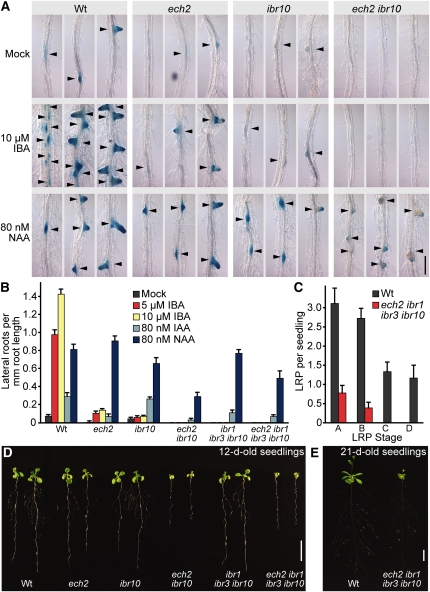Figure 6.
ech2 ibr10 and ech2 ibr1 ibr3 ibr10 Are Defective in Lateral Root Production.
(A) ech2 ibr10 displays decreased DR5-GUS activity in lateral roots. Four-day-old light-grown wild-type (Wt), ech2-1, ibr10-1, and ech2-1 ibr10-1 seedlings carrying DR5-GUS were transferred to medium supplemented with ethanol (mock) or the indicated auxin and grown for an additional 4 d under yellow-filtered light at 22°C prior to staining for GUS activity for 1 h. Lateral roots and LRPs are highlighted with arrowheads. Bar = 200 μm.
(B) ech2 mutants produce fewer lateral roots than the wild type. Emerged lateral roots of wild-type, ech2-1, ibr10-1, ech2-1 ibr10-1, ibr1-2 ibr3-1 ibr10-1, and ech2-1 ibr1-2 ibr3-1 ibr10-1 were counted 4 d after transfer of 4-d-old seedlings to medium supplemented with either ethanol (mock) or the indicated auxins (mean + se, n ≥ 12).
(C) ech2 ibr1 ibr3 ibr10 displays fewer LRPs. Eight-day-old wild-type and ech2-1 ibr1-2 ibr3-1 ibr10-1 seedlings were cleared, and the number and stage of LRPs recorded (+se, n = 18). Stage A spans of the first anticlinal division of a pericycle cell to an LRP with three cell layers. Stage B includes unemerged lateral roots with more than three cell layers. Stage C includes emerged lateral roots shorter than 0.5 mm. Stage D consists of emerged lateral roots longer than 0.5 mm.
(D) Twelve-day-old wild-type, ech2-1, ibr10-1, ech2-1 ibr10-1, ibr1-2 ibr3-1 ibr10-1, and ech2-1 ibr1-2 ibr3-1 ibr10-1 light-grown seedlings. Bar = 1 cm.
(E) Twenty-one-day-old wild-type and ech2-1 ibr1-2 ibr3-1 ibr10-1 light-grown plants. Bar = 1 cm.

